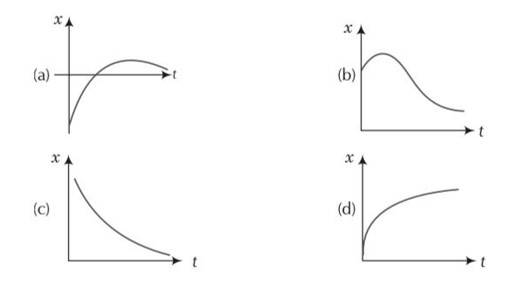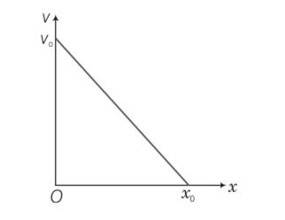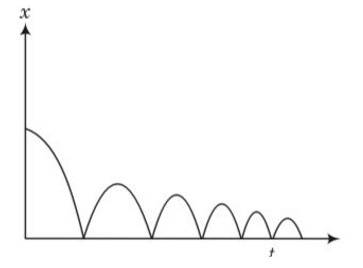physics ncert solutions class 11th
Get insights from 952 questions on physics ncert solutions class 11th, answered by students, alumni, and experts. You may also ask and answer any question you like about physics ncert solutions class 11th
Follow Ask QuestionQuestions
Discussions
Active Users
Followers
New answer posted
4 months agoContributor-Level 10
This is a multiple choice answer as classified in NCERT Exemplar
(c) Time taken to travel first half distance t1=
Time taken to travel second half distance t2=
Total time =t1+t2
formula for average velocity will be =
formula for average velocity will be= vav=average speed= total distance/total time =
New answer posted
4 months agoContributor-Level 10
This is a multiple choice answer as classified in NCERT Exemplar
(b) For maximum and minimum displacement we have to keep in mind the magnitude and direction of maximum velocity.
As maximum velocity in positive direction is vo maximum velocity in opposite direction is also vo.
Maximum displacement in one direction = voT
Maximum displacement in opposite direction=-voT
Hence -voT
New answer posted
4 months agoContributor-Level 10
This is a multiple choice answer as classified in NCERT Exemplar
(a) As the lift when coming downward directions displacement will be negative. We have to see whether the motion is accelerating or retarding.
We know that due to downward motion displacement will be negative, when the lift reaches 4th floor is about to stop hence motion is retarding in nature.
As displacement is in negative direction . velocity will also be negative i.e v<0
New answer posted
4 months agoContributor-Level 10
This is a multiple choice answer as classified in NCERT Exemplar
(b) To making it vanish one part must cancel other part which is only possible in graph b.
As there are opposite velocities in the interval 0 to T hence average velocity can vanish in b .
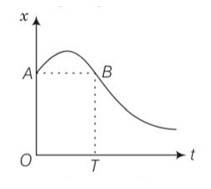
New answer posted
4 months agoContributor-Level 10
This is a short answer type question as classified in NCERT Exemplar
let initial velocity Vi
Distance travelled in time t= xi
For the graph
tan = vi/xi= vi-v/x
V= -vix/xi+Vo
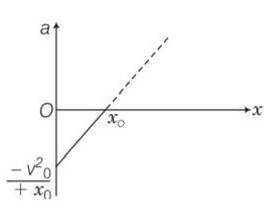
Acceleration, a = dv/dx= -vidx/xidt
So a= -viv/xi=
New answer posted
4 months agoContributor-Level 10
This is a short answer type question as classified in NCERT Exemplar
When the ball dropped from the building u1=0, u2=40m/s
Velocity of the dropped ball after time t
V1=u1+gt
V1 = gt
For ball thrown up u2=40m/s
Velocity of the ball after time t
V2=u2-gt
=40-gt
Relative velocity =v1-v2
=gt- [-40-gt]=40m/s
New answer posted
4 months agoContributor-Level 10
This is a short answer type question as classified in NCERT Exemplar
When the ball dropped from the building u1=0, u2=40m/s
Velocity of the dropped ball after time t
V1=u1+gt
V1 = gt
For ball thrown up u2=40m/s
Velocity of the ball after time t
V2=u2-gt
=40-gt
Relative velocity =v1-v2
=gt- [-40-gt]=40m/s
New answer posted
4 months agoContributor-Level 10
This is a short answer type question as classified in NCERT Exemplar
speed of first car = 18km/h
Speed of second car = 27km/hr relative with respect to each other is 18+27=45km/h
Distance between cars = 36km
Time = 36/45=0.8h
Distance covered by bird = 36 (0.8)=28.8km
New answer posted
4 months agoContributor-Level 10
This is a short answer type question as classified in NCERT Exemplar
(a) x (t)=x0 (1- )
V (t)=dx/dt= x (t)=x0 ( )
A (t)= x ( t)=x0 ( )
(b) when t=o x (t)= x (t)=x0 (1- )= x (t)=x0 (1-1)=0
x (t) is maximum when t=
x (t) is maximum when t=
v (t) is maximum when t= , v (0)=x0
v (t) is maximum when t= v ( )=0
a (t) is maximum when t= , a ( )=0
a (t) is maximum when t= , a ( )=-x0 2
New answer posted
4 months agoContributor-Level 10
This is a short answer type question as classified in NCERT Exemplar
It is clear from the graph that displacement x is positive throughout . ball is dropped from height and its velocity increases in downward direction due to gravity pull. In this condition v isnegative but acceleration of the ball equal to acceleration due to gravity.
velocity time graph
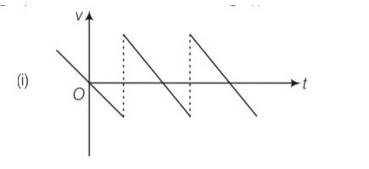
Acceleration time graph
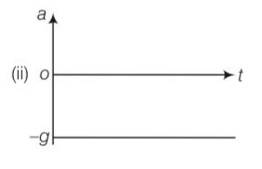
Taking an Exam? Selecting a College?
Get authentic answers from experts, students and alumni that you won't find anywhere else
Sign Up on ShikshaOn Shiksha, get access to
- 65k Colleges
- 1.2k Exams
- 686k Reviews
- 1800k Answers

